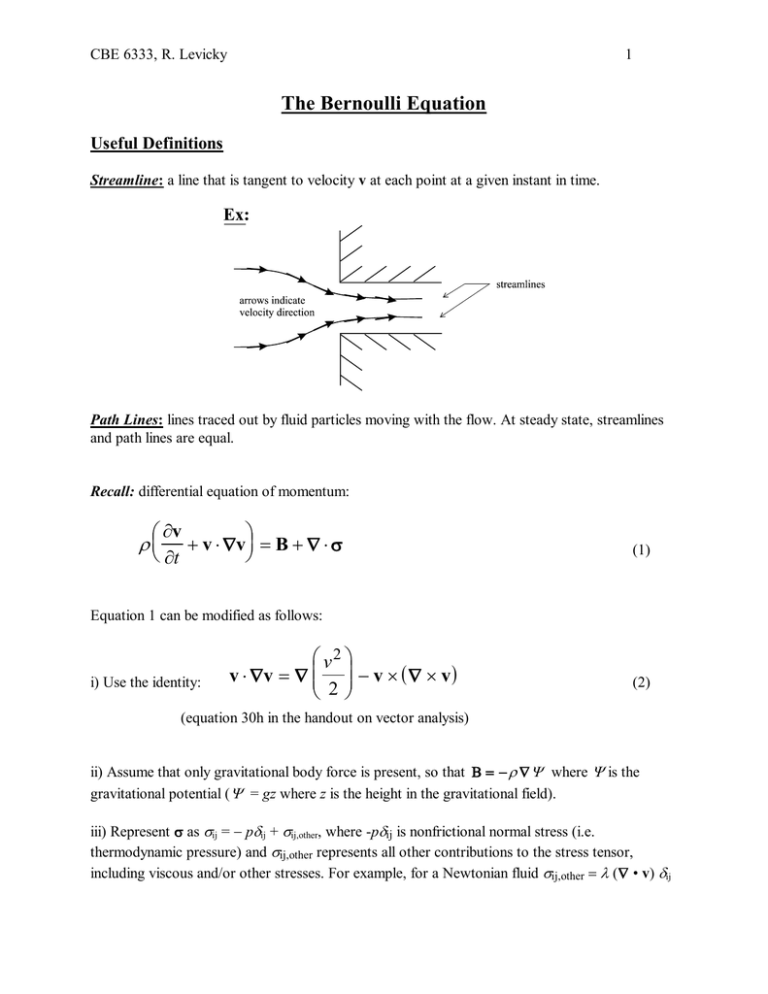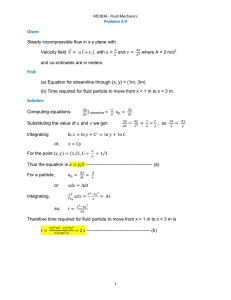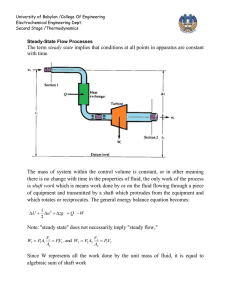Handout 13
advertisement

CBE 6333, R. Levicky 1 The Bernoulli Equation Useful Definitions Streamline: a line that is tangent to velocity v at each point at a given instant in time. Path Lines: lines traced out by fluid particles moving with the flow. At steady state, streamlines and path lines are equal. Recall: differential equation of momentum: v v v B t (1) Equation 1 can be modified as follows: i) Use the identity: v2 v v v v 2 (2) (equation 30h in the handout on vector analysis) ii) Assume that only gravitational body force is present, so that where is the gravitational potential ( = gz where z is the height in the gravitational field). iii) Represent as ij = pij + ij,other, where -pij is nonfrictional normal stress (i.e. thermodynamic pressure) and ij,other represents all other contributions to the stress tensor, including viscous and/or other stresses. For example, for a Newtonian fluid ij,other ( • v) ij CBE 6333, R. Levicky 2 + 2 eij (see equations 20 and 24 in Handout 7); note, however, that we are not necessarily assuming a Newtonian fluid. With modifications (i) through (iii), equation 1 becomes: v v2 v v Ψ p σ other 2 t (3) v2 v p 1 v v Ψ σ other t 2 (4) 1 other represents force acting at a point in space due to stresses other than thermodynamic pressure. We 1 now assume that other only includes viscous frictional forces exerted by the surrounding fluid, f F (units force/mass), and "shaft" forces due to moving machinery fS, All the terms in equation 4 have the units of force per unit mass (ex. lbf / slug). Now, v2 v p v v f F fS t 2 Equation 5 will be used to derive the so-called "Extended Bernoulli Equation." The Extended Bernoulli Equation ("EBE") The EBE is derived by integrating equation 5 between points 1 and 2 on a streamline: Along the streamline, ds is used to represent a differential displacement: (5) CBE 6333, R. Levicky 3 Taking the dot product of equation 5 with ds and integrating between 1 and 2: 2 2 v t ds 1 1 2 2 2 2 2 v2 ds v v ds Ψ ds p ds f F ds f S ds (6) 2 1 1 1 1 1 The following facts will be useful: i). From our review of vector analysis, the dot product of a gradient of a scalar field with a differential displacement is equal to the differential change in the scalar (i.e. S dr = dS). In equation 6, the differential displacement dr is represented by ds. ii). The vector v ( v) is perpendicular to v and therefore to ds, since ds points along the streamline. Thus, [v ( v)] ds 0 . 2 iii). The term f F ds is force times displacement and represents the work performed, per unit 1 mass of fluid, by frictional forces acting between fluid particles as the fluid flows from point 1 to 2. This term can therefore be written as the "frictional work" wF: 2 f F ds wF (wF is frictional work performed by the streamline fluid on the surrounding 1 fluid) 2 iv). Similarly, the term f S ds is shaft work performed per unit mass of fluid flowing from point 1 1 to point 2. This term will be written as wS: 2 f S ds wS (wS is shaft work performed by fluid on the surroundings) 1 Applying considerations (i) – (iv), equation 6 becomes: CBE 6333, R. Levicky 4 2 2 2 v2 v dp 1 t ds 1 d 2 1 dΨ 1 wF wS 2 Assuming steady ( (7) v = 0 ), incompressible ( = constant) flow, equation 7 can be integrated to t give v2 v p p1 1 Ψ 2 Ψ1 2 wF wS 2 2 2 2 (8) Since is the gravitational potential gz, v2 v1 p p1 g ( z 2 z1 ) 2 wF wS 2 2 2 (9) Equation 9 is the Extended Bernoulli Equation, and holds for steady, incompressible flow along a streamline. Notes regarding the EBE: i). ALL the terms are in units of energy or work per unit mass of flowing fluid. ii). The terms on the left of equation 9 are the change in kinetic energy, gravitational potential energy, and flow work performed per unit mass of fluid, as fluid flows from point 1 to point 2. iii). wF is work done by the flowing fluid against retarding frictional forces between points 1 and 2. wF > 0 for flows of real fluids. wF < 0 is unphysical. wF is often rewritten as: w F gH L g: HL : gravitational acceleration constant called “head loss”, with units of length. (10) Equation 10 defines HL. For example, consider the following situation where fluid flows from point 1 to point 2 inside a pipe: CBE 6333, R. Levicky 5 If the flow is steady and incompressible, and z1 = z2, v1 = v2, and wS = 0, then equation 9 becomes: p = p2 – p1 = - gHL iv). The shaft work wS is positive, wS > 0, if work is done by the fluid (on a turbine, for instance). wS < 0 if work is done ON the fluid (ex. by a pump). In terms of head loss, the EBE is written: v2 2 v12 p p1 g ( z2 z1 ) 2 gH L wS 2 (11) (steady, incompressible flow, points 1 and 2 are on the same streamline) Special Cases of the EBE: 1. Frictionless flow with no shaft work. Then HL = 0, wS = 0, and the EBE becomes: v2 2 v12 p p1 g ( z2 z1 ) 2 0 2 (12) Equation 12 applies to steady, incompressible, frictionless flow with zero shaft work, where points 1 and 2 are on the same streamline. Equation 12 is known simply as the Bernoulli Equation. 2. Irrotational Flow: Then v = 0. Therefore, if the derivation of the Extended Bernoulli Equation was repeated from equation 6, for irrotational flow we would not need to invoke the 2 condition that points 1 and 2 are on the same streamline in order to drop the v v ds 1 term (see equation 6). Thus, for irrotational flow, the EBE (equation 9) holds between any two CBE 6333, R. Levicky 6 points 1 and 2 in the flow, where 1 and 2 do not have to lie on the same streamline. The flow still has to be steady and incompressible, however. 3. The EBE (equation 9) can be integrated over the cross-section of a pipe or other control volume. For instance, we could have a control volume like that shown below: Designating the entry port as port "1" and the exit port as port "2", we want to sum equation 9 for all streamlines passing through these ports. The contribution of each streamline to the sum must be weighed by the rate at which fluid mass passes along it through the control volume. This rate of mass flow is v n , where n is the unit normal to the surface of the control volume. Integrating each term in equation 9 over all streamlines (i.e. over the areas of the ports), equation 9 becomes v2 2 gz A2 v2 p v ndA + gz 2 A 1 dW p dWs v ndA = - F dt dt (13) (steady, incompressible flow) In equation 13, dWF/dt = w f ( v n)dA is the rate of work against retarding frictional forces in A2 the control volume. This term includes work done along all streamlines, not just along a particular streamline. Similarly, dWS/dt = ws ( v n)dA is the rate of shaft work performed in the control A2 volume, inclusive of contributions from all streamlines. If v, z, and p can be regarded as uniform over the areas A1 and A2, then equation 13 simplifies to: v 2 p v2 p dWF dWs * 2 gz 2 1 gz 1 m (14) 2 1 2 2 dt dt (steady, incompressible flow; uniform properties over A1 and A2 ) CBE 6333, R. Levicky Here m* = ( v n)dA A1 7 = ( v n)dA is the mass flowrate of fluid through the ports. A2 Since steady state was assumed, mass flow rate "in" equals mass flow rate "out." Equation 13 can be compared with the integral version of the total energy balance. The total energy balance was derived in the handout on integral balance equations. For steady, incompressible flow through a control volume containing an entry port 1 and an exit port 2, the total energy balance becomes v2 p dQ dWs gz u + v n d A = 2 d t dt A1 A2 (15) internal energy per unit mass of fluid Subtracting equation 13 from equation 15 yields u v n dA = A1 A2 dQ dWF dt dt (16) or out rate of U in rate of U u v n dA = - u v n dA + A2 A1 rate of frictional work rate of heat addition dQ dt dWF dt (17) Here, U means "internal energy." Equation 17 states that the internal energy of the fluid flowing out of the control volume at port 2 equals the internal energy flowing into the control volume at port 1, plus the heat added and work done against frictional resistances as the fluid passes through the control volume. In particular, we see that the work of friction WF is dissipated to internal energy. Equation 17 is a specialized form of the 1st Law of Thermodynamics. Note that a term due to compression/expansion of the system (often referred to as "PV work") is not present since steady state conditions, assumed in equations 13 and 15, imply that the control volume does not change. Calculating Power: CBE 6333, R. Levicky 8 Since the shaft work wS is work performed per unit mass of flowing fluid, the power P, which is shaft work performed per unit time, is P = m*wS (18) where m* is the mass flowrate of fluid (mass/time). Common units of power are: 1 watt (W) = 1 Joule/s 1 lbf ft 1 horsepower (hp) = 1.356 watt sec 550




